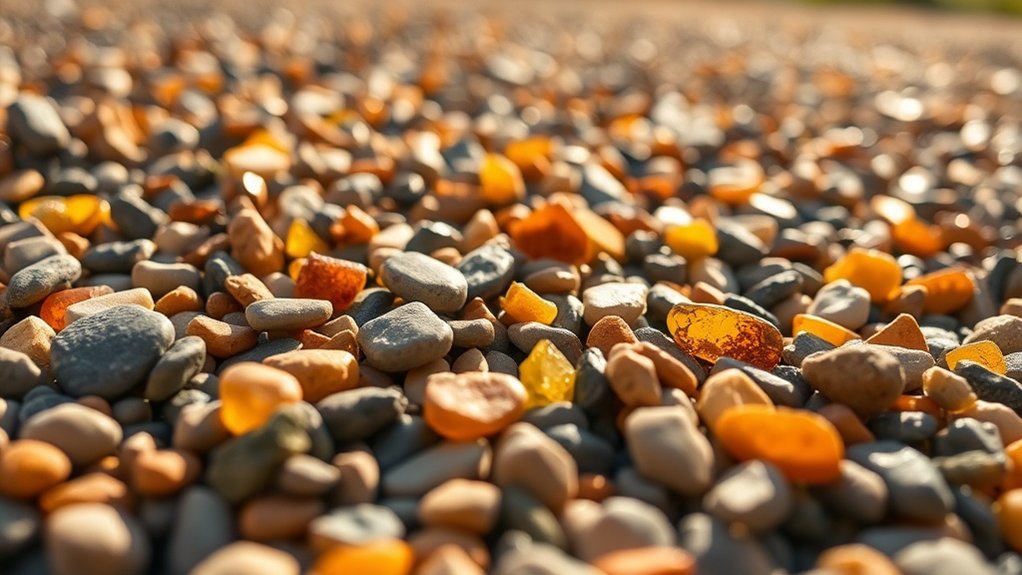When selecting aggregates for resin-bound gravel applications, consider options such as washed gravels, limestone, and granite. These materials are durable and perform well. Angular aggregates offer better interlock and strength, while finer sizes (2-6mm) improve permeability and resin bonding.
Local sourcing is important too, as it can help reduce transport emissions. Aesthetically, there are various colour and texture choices for personalisation. Don’t overlook maintenance needs to ensure longevity. For more tips on optimising your selections and achieving lasting performance, explore further resources.
Key Takeaways
- For high-traffic areas, opt for durable aggregates like granite and basalt due to their hardness and resistance to wear.
- Angular aggregates sized 2-5mm offer excellent grip and interlock on sloped surfaces, improving stability.
- You can choose from a variety of natural aggregates to match your aesthetic preferences, providing different colours and textures for design.
- High porosity aggregates enhance drainage, making them ideal for damp climates and reducing the risk of puddles.
- Regular maintenance with suitable cleaning methods is vital to maintain the performance and appearance of resin-bound gravel surfaces.
Types of Natural Aggregates for Resin-Bound Surfaces
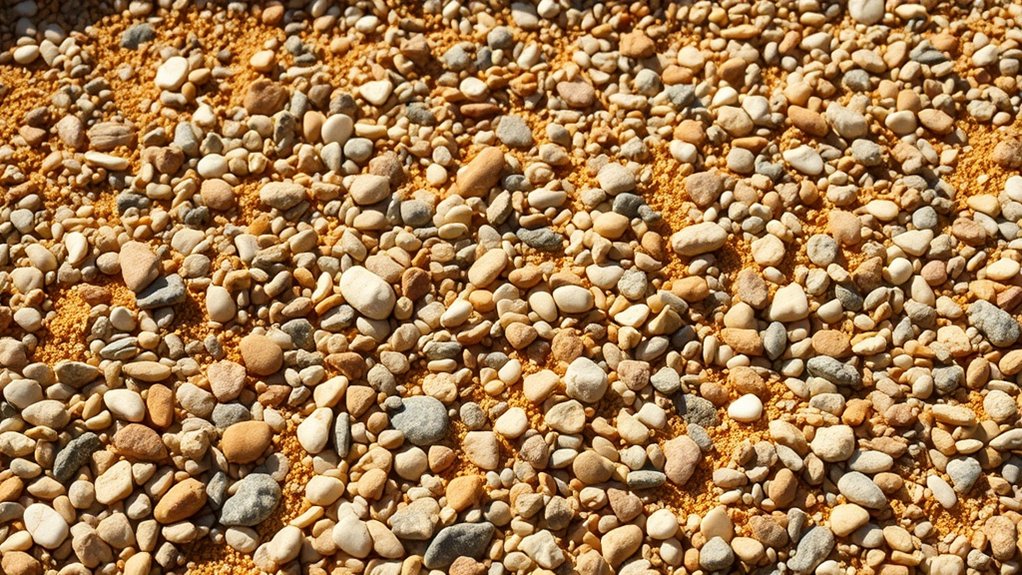
When creating resin-bound surfaces, selecting the right natural aggregates is vital for both performance and aesthetics. Common options include washed and kiln-dried gravels, limestone, granite, quartz, and sandstone, each offering distinct properties and visual appeal. Proper preparation of aggregates ensures a high-quality finished product, as quality aggregates are carefully washed and kiln-dried to remove dust and moisture. Additionally, sourcing local aggregates reduces transport emissions and supports local economies. The size of the aggregates, typically ranging from 2mm to 6mm, is important for ensuring good permeability and resin bonding. Angular aggregates provide better mechanical interlock and increased surface strength, while rounded stones result in a smoother finish.
Characteristics of Aggregates and Their Performance
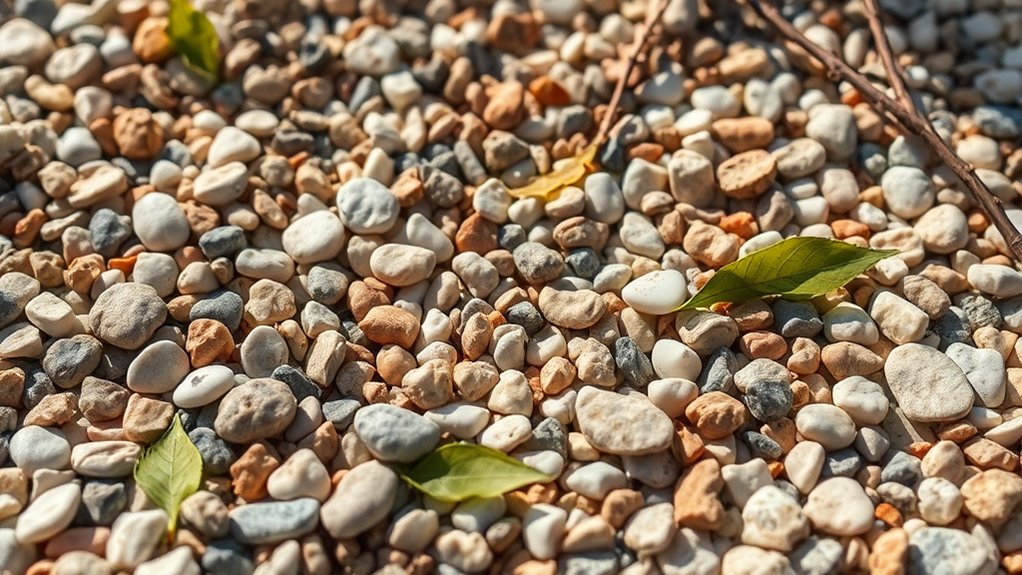
When choosing aggregates for resin-bound gravel, it’s essential to consider durability, aesthetics, and load performance. The right mix of these factors not only enhances visual appeal but also ensures the surface lasts longer and maintains its structural integrity. For example, using tougher aggregates can improve durability, while selecting attractive colours can boost the overall look. Understanding how these elements work together will help you create a resilient and visually pleasing finish. Furthermore, selecting aggregates that promote high porosity can significantly enhance drainage capabilities, reducing puddling and improving overall surface longevity. Choosing UV-stable resins ensures that the surface maintains its aesthetic qualities over time, preventing yellowing and enhancing the longevity of the investment.
Aggregate Durability Factors
Durability in resin-bound gravel applications depends on the right choice and performance of aggregates. Consider the longevity of aggregates, focusing on size, shape, and compatibility with materials. Angular stones sized 2-5mm offer the best grip, especially for sloped surfaces. Proper ground preparation is essential for successful installation to ensure stability and longevity.
In wet climates, aggregates like granite and basalt are preferred for their low permeability and durability.
Ensure the aggregates are well-graded and dry to avoid resin contamination. Permeability is vital, allowing water to drain effectively and reducing potential damage. Adding anti-slip textures improves safety, while UV and chemical resistance helps maintain performance over time. When sourcing aggregates, choose reputable brands that meet industry standards. It’s also crucial to get the resin-to-aggregate ratios and depth correct for stability.
Aesthetic Considerations
Selecting the right aggregates is crucial not only for durability but also for the visual appeal of resin-bound gravel surfaces. By considering colour harmony and texture contrast, you can create stunning effects. Different aggregate sizes and materials can form distinctive patterns that enhance your landscape design.
| Aesthetic Feature | Description |
|---|---|
| Colour Options | Extensive range for customisation |
| Texture Variety | From smooth to rough finishes |
| Design Personalisation | Unique patterns and styles |
| Natural Aesthetic | Resembles natural stone |
These features offer versatility, allowing for seamless integration into various styles, whether rustic or modern. Ultimately, choosing the right aggregates ensures a visually cohesive outdoor space that aligns with your design vision.
Performance Under Load
To ensure optimal performance under load for your resin-bound gravel projects, it’s important to understand the different aggregates available. Here are some key points to consider when selecting aggregates based on load-bearing capacity:
- Granite and quartz are highly durable, providing excellent hardness and resistance to wear, which enhances their load-bearing capabilities.
- Basalt and flint have exceptional compressive strength, making them ideal for areas with heavy vehicular traffic.
- Limestone may be aesthetically pleasing but has lower crush resistance, making it less suitable for applications with significant load demands.
Using graded aggregates can enhance interlock and density, leading to improved load distribution.
Additionally, the quality of the substrate is crucial; a strong base is essential for the performance of your chosen aggregate.
Implementing reinforcement techniques can further enhance load-bearing capacity, particularly in fluctuating conditions.
Make informed choices to ensure durability and longevity in your projects.
Selecting Aggregates Based on Application Requirements
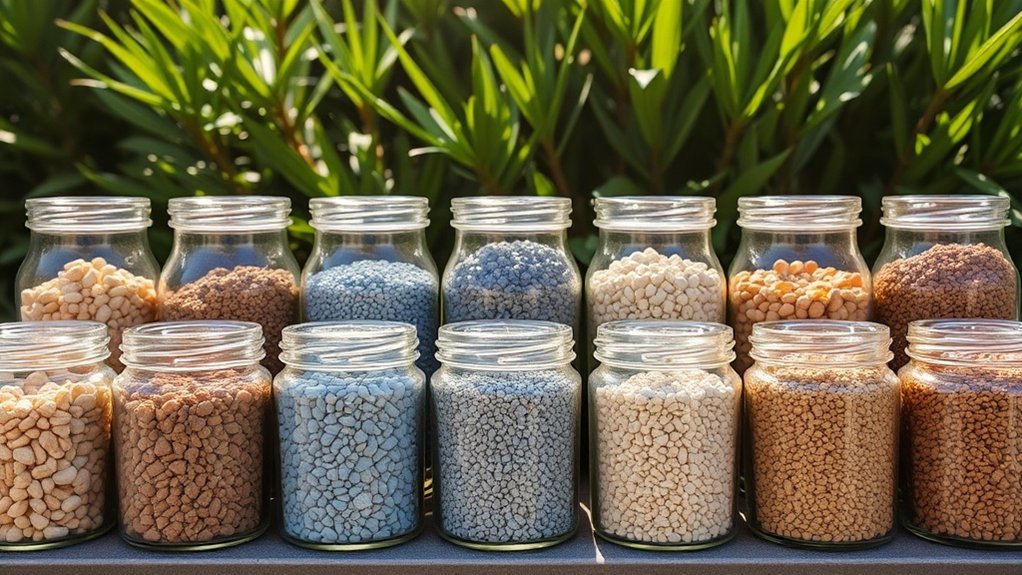
When selecting aggregates for resin-bound gravel applications, it’s important to ensure they meet specific performance requirements.
Start by considering the aggregate size: for pedestrian footpaths, opt for 1-3 mm or 2-5 mm aggregates for the right texture and bonding. For driveways, coarser aggregates in the 18-20 mm range are ideal, while commercial areas typically need thicker layers around 22 mm for enhanced durability.
In tree pits, larger aggregates (6-10 mm) allow for root movement.
Make sure the aggregates are free from dust and organic material to promote strong adhesion.
Also, assess their ability to withstand environmental stresses, such as freeze-thaw cycles.
This careful selection process ensures your resin-bound gravel meets both performance and aesthetic standards effectively.
Environmental and Regulatory Considerations for Aggregate Use
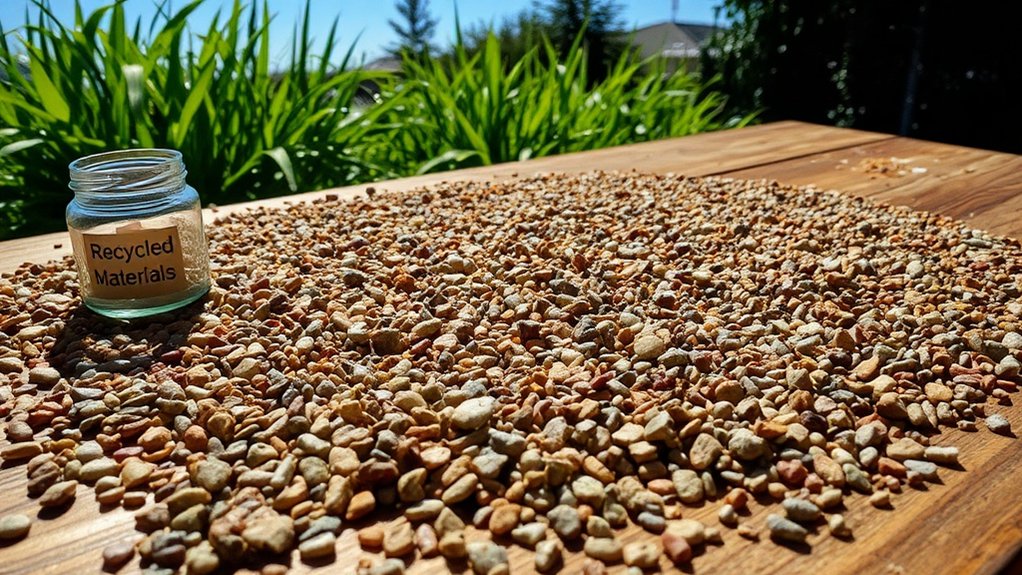
When choosing aggregates for resin-bound gravel applications, it’s vital to consider both performance and environmental regulations.
- Ensure you comply with SUDS (Sustainable Drainage Systems) regulations, especially for areas larger than 5m², to prevent planning issues.
- Opt for locally sourced aggregates to cut down on transport emissions and lessen your project’s environmental footprint.
- Use size-graded aggregates to enhance permeability, which helps with natural groundwater recharge and effective drainage.
Importance of Surface Preparation and Aggregate Integration
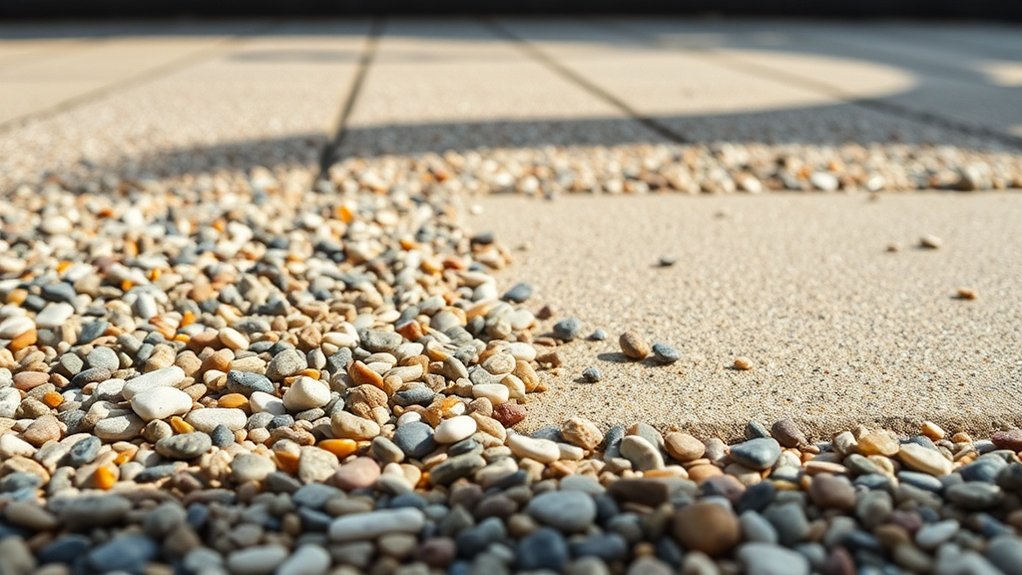
Proper surface preparation and effective aggregate integration are crucial for a durable and attractive resin-bound gravel installation.
Begin by cleaning the surface to eliminate any debris. Next, excavate and compact a solid sub-base to ensure stability. It’s important to control moisture; ensure the surface is completely dry before applying the resin.
When it comes to aggregate integration, follow the manufacturer’s mixing ratios closely and use a forced action mixer for consistency.
Choose high-quality aggregates, paying attention to size variation and texture for better grip. Each batch should be uniform in colour and texture to prevent inconsistencies.
Aesthetic and Functional Benefits of Various Aggregates
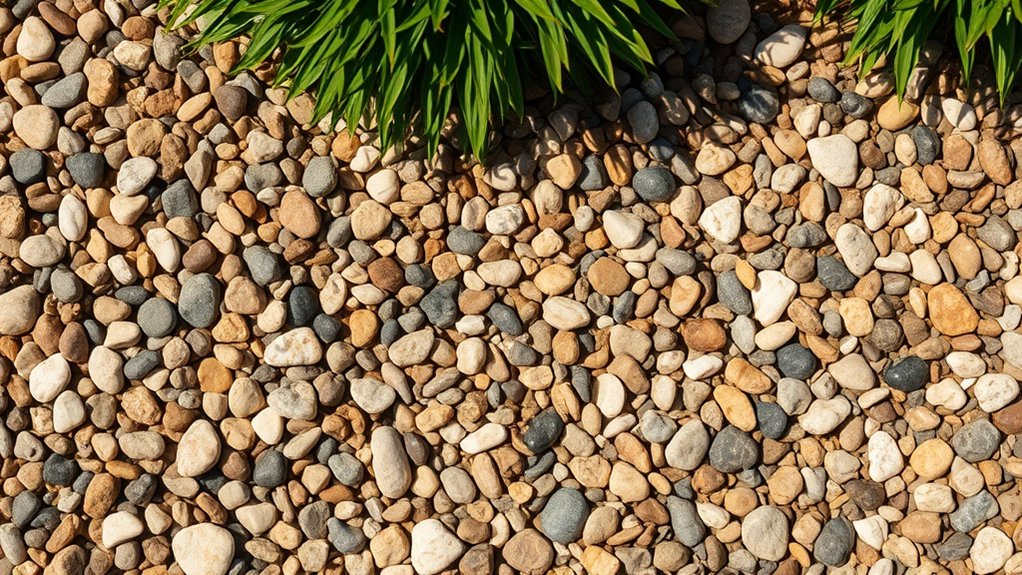
The choice of aggregates may seem minor, but it significantly influences both the aesthetic and functional aspects of resin-bound gravel installations.
Your colour selection can greatly enhance the visual appeal, while the texture of the aggregates affects safety and usability.
Here are some key benefits:
- Customisation: A variety of colours and textures enables you to design surfaces that complement your existing landscape.
- Durability: Selecting the right aggregates ensures resilience against heavy foot traffic and adverse weather conditions.
- Slip Resistance: Textured aggregates provide a naturally slip-resistant surface, enhancing safety for users.
Maintenance and Care for Resin-Bound Gravel Surfaces
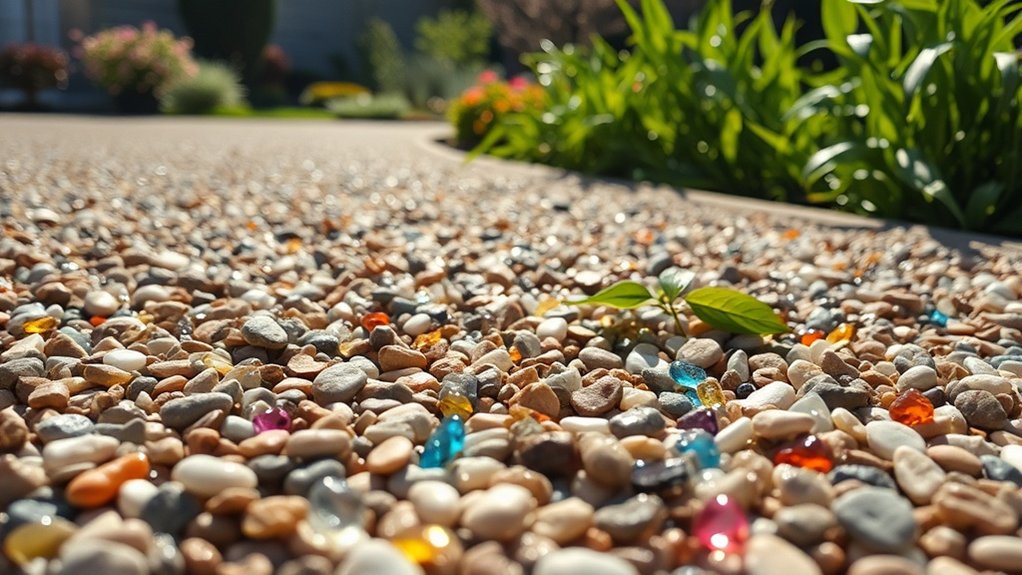
To ensure your resin-bound gravel surfaces last and function well, regular maintenance is key.
Start with routine sweeping using a stiff broom to prevent debris build-up. For larger areas, a non-metallic leaf blower can help maintain permeability.
Set up a maintenance schedule that includes periodic rinsing with a garden hose or a gentle pressure wash to clear away dirt. Address spills quickly to avoid staining, using mild detergent if needed.
Hand-pull any weeds and check for surface wear regularly. In high-traffic areas, clean more often and consider applying UV-stable coatings for extra protection.
Following these simple steps will keep your resin-bound gravel surfaces looking great and in good condition.
Frequently Asked Questions
What Are the Cost Differences Between Various Aggregate Types?
When comparing costs, you’ll notice that prices for aggregates can vary significantly. Common aggregates like gravel are generally more economical, while premium options, such as marble or granite, tend to be pricier due to their scarcity and the complexities involved in sourcing them. For example, if you’re planning a driveway, gravel is a budget-friendly choice, whereas using granite could substantially raise your expenses.
How Do Temperature Fluctuations Affect Aggregate Performance?
Temperature fluctuations significantly impact the performance of aggregates. Extreme heat or cold can weaken bonding and structural integrity, resulting in reduced durability and a higher likelihood of cracking or surface defects. For example, in winter, frost can penetrate concrete, leading to freezing and thawing cycles that cause damage. It’s essential to consider these effects when selecting materials for construction projects to ensure long-lasting results.
Can Recycled Aggregates Be Used in Resin-Bound Applications?
Yes, recycled aggregates can be used in resin-bound applications. Using these materials not only helps minimise landfill waste and reduce carbon emissions, but it also maintains the necessary performance, durability, and visual appeal for your projects. For instance, using recycled aggregates in driveways or patios can be a sustainable choice without compromising quality.
What Is the Lifespan of Different Aggregate Materials?
Granite aggregates generally have a lifespan of 20 to 25 years, while synthetic options can last between 15 and 30 years, depending on the resin used. This comparison highlights how the durability of aggregate materials significantly affects the overall performance of resin-bound gravel applications.
How Does Aggregate Choice Impact Installation Time?
The size of the aggregate you choose significantly affects installation time. Larger aggregates can slow down mixing and spreading, while smaller ones improve workability. Using the right installation methods can boost efficiency, shorten project timelines, and ensure a smoother finish. For instance, if you’re laying a patio, opting for smaller aggregates can make the job quicker and easier, resulting in a better overall appearance.
Conclusion
When selecting aggregates for resin-bound gravel applications, you’re creating a blend of durability and visual appeal. Each choice is crucial, much like the pieces of a jigsaw puzzle, adding to the strength and aesthetic of the surface. By assessing performance traits and specific application requirements, you ensure a long-lasting and attractive finish. Don’t forget that proper surface preparation and regular maintenance are key to keeping your installation looking great and functioning well over the years.
